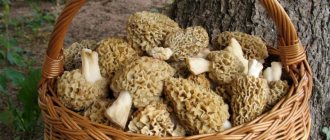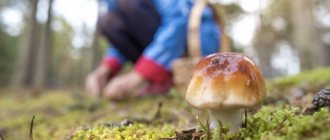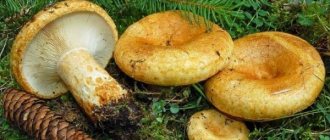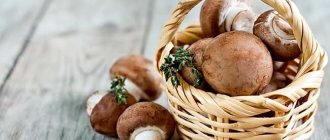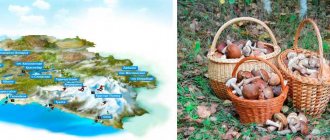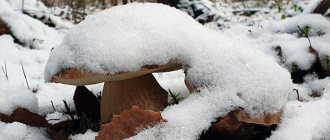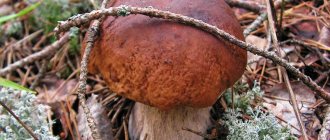Author: Horned Corpse Eaters
01 August 2016 17:32
Tags: mushrooms tips
62286
12
They say that a real mushroom picker will always distinguish an edible mushroom from an inedible one. Maybe. But what to do if you don’t know much about mushrooms, but you really want to collect them? Help posters will clearly show you what the main edible mushrooms look like.
0
See all photos in the gallery
Most often found in central Russia are honey mushrooms, boletuses, boletuses, chanterelles, and russula. But there are also little-known mushrooms, or rather, we often see them in the forest, but we don’t know the name, and yet they are very edible and even tasty. For example: valui, smoothy, goat, bitter and others. On the eve of the mushroom period itself, the editors invite you to see what edible mushrooms look like: you will see not only the characteristic features of mushrooms, but also their doubles, instructions on how to prepare them, where they grow, etc. It is especially convenient to save these posters in your phone and check how they say, right on the spot.
Description of mushrooms
Mushroom pickers begin collecting spring mushrooms in May and finish in late October, in November under favorable weather conditions. Before going into the forest, it is important for a beginner to take time to study the descriptions of the characteristics and types of forest plants.
Often for this purpose they use a directory of mushrooms of the Stavropol Territory, which helps to correctly understand which mushrooms are edible and which are poisonous.
The general division occurs into 4 types:
- edible;
- conditionally edible;
- inedible;
- poisonous.
Names of mushrooms of the region listed in the Red Book
There are mushrooms in the Stavropol Territory that are listed in the Red Book of the Russian Federation. They should never be collected as they are essentially an endangered species. These include:
- Varnished tinder fungus. This is a completely inedible mushroom that grows on the territory of the Russian Forest reserve. Despite the fact that it is prohibited to collect such fruits, they are used in industry for the production of dietary supplements.
- Vaulted star. The unusually shaped mushroom is inedible, however, it is used for medicinal purposes. It grows in the vastness of the same reserve.
- Grifola curly. The second name of the fruit is ram mushroom. It is edible, but it is prohibited to collect it in the Stavropol region. It grows on the territory of the landscape natural monument “Mount Beshtau”.
- Pine cone fungus. A conditionally edible mushroom, named for its shape. It grows in the same area as the ram mushroom.
The Stavropol Territory is a region that is literally dotted with mushrooms - well-known and unusual, rare. The “quiet hunting” season here lasts quite a long time, so mushroom pickers have the opportunity to make several trips to pick up their favorite fruits to prepare them for the winter.
Harmful properties
The delicacy is not a dietary product: it is difficult to digest. The food is heavy and should not be eaten haphazardly by those who have gastrointestinal problems. The digestion process slows down in the stomach. Chitin, which is part of the legs of autumn varieties, if prepared incorrectly, starts the process of rotting.
In the environment, in the soil, there are toxins that are completely absorbed by the root system of organisms, especially those growing near busy roads. Botulism occurs after improper preparation without soaking and thorough washing in several waters.
Guide to Edible Species of the Region
In the Stavropol region you can find a large number of edible fruits. From year to year, local mushroom pickers harvest a stable and generous harvest. Therefore, every lover of “silent hunting” will return with baskets full of delicious forest gifts.
Chanterelles
Chanterelles are one of the few types of mushrooms that are collected in the Stavropol region before the onset of persistent frosts. The main parameters of the mushroom are as follows:
- Hat. Its color is bright yellow or orange, its size is 5-10 cm in diameter. It has a funnel whose circumference is about 2 cm.
- Leg. Painted orange, 7-8 cm high.
- Pulp. Quite dense and fleshy, when cut it begins to release abundant juice. Pleasant to the taste, and its aroma is reminiscent of fruit.
The first chanterelles begin to appear in early June. This type of mushroom prefers coniferous forests.
Saffron milk caps
In the Stavropol region you can find two types of saffron milk caps - spruce and pine. Both varieties have the same cap and stem colors, that is, red, which is why these fruits are called that.
The cap grows up to 8 cm in diameter, and the height of the stem can reach 7 cm. The fruit looks quite dense, but in fact it is easily deformed under mechanical stress. The aroma of saffron milk caps resembles the smell of fruit.
Honey mushrooms
You may be interested in: How do edible talkers differ from false mushrooms? How many days after rain do mushrooms grow? Bittersweet mushroom: photo and detailed description Autumn honey mushrooms are the most common type of mushroom.
And the main feature is that they grow exclusively on the surface of trees, in particular on stumps. Main characteristics of the honey agaric:
- the cap is round, colored light brown, and its size is about 7-8 cm;
- the leg is large, white, up to 10 cm high, its inner part is covered with fibers;
- The pulp is dense and has a pleasant, slightly sour taste.
Many mushroom pickers look for honey mushrooms on birch trees. They can also grow on dead wood in large groups. In one approach you can collect from 10 to 20 such specimens. It is best to give preference to young fungi, as they have a more delicate, refined taste and aroma.
Oyster mushrooms
You can also find oyster mushrooms in the Stavropol region. Such fruits are classified as parasitic species, since they often settle on living trees and feed on their juices. Although in most cases the place where they grow becomes dead wood or stumps. But for humans, oyster mushroom is completely safe. Moreover, it is very tasty and very healthy. The flesh of the mushroom is very aromatic and has a very pleasant taste.
The peculiarity of this mushroom is that it is similar in shape and appearance to the human ear. The oyster mushroom has practically no stem - it is impossible to see it due to the fact that the mushroom is tightly attached to the bark of the tree on which it grows.
The fruit is ashy in color and may have a bluish tint. The diameter of the “family” can reach 15-20 cm. As can be seen in the photo, such specimens grow in large groups. Their total weight is sometimes 1-2 kg. It is better to pick the fruits in “fans”, as they grow, and not to separate them from each other.
Rows
In the Stavropol region, the purple-footed row grows on alkaline soil. The mycelium forms large colonies or rows, or, as people say, “witch circles.”
The harvest season for this type of row is September. At the same time, experienced mushroom growers recommend picking fruits only in dry weather, since after rain they become sticky and slippery.
The bluefoot cap grows up to 6-15 cm, but in some cases it can be quite large. The pulp of a young mushroom is dense and thick, while that of a mature one is loose. Color can vary from gray-violet to gray-brown. The leg is smooth, not very high, there is a thickening at the base. It reaches 5-12 cm in length.
Mokhoviki
Green moss mushroom belongs to the category of edible mushrooms, and the name of the mushroom speaks for itself, since it grows on soil generously covered with moss. The cap has a diameter of 4 to 12 cm. It is usually colored greenish-gray or olive.
The leg is from 3 to 11 cm high, cylindrical in structure, widened towards the top. Sometimes a brownish mesh forms on it. The pulp is white, but may turn blue when cut.
Moss mushrooms are very tasty boiled or fried. They are also often used for pickling, but are used less often for pickling.
Important!
In some cases, the surface of flywheels is covered with mold, which is dangerous to human health. To avoid possible consequences, it is necessary to collect fruits without the presence of a moldy edge.
Russula
Russulas may have different colored caps, but their taste is almost always the same. Despite the fact that mushrooms are not considered a delicacy, they are in no way inferior to other edible fruits.
The cap of the russula is matte, pinkish, yellowish or greenish. Its diameter ranges from 4-12 cm. At first it is hemispherical, after which it becomes almost completely flat.
The leg is 3-7 cm high, its color matches the shade of the cap section. In young fruits it is quite dense, but in mature ones it becomes hollow. The pulp is fleshy, quite dense, but brittle, white. The taste is pleasant, but it has no pronounced odor.
boletus
The main feature of this fruit is the place of its growth, since it forms mycorrhiza only with birch trees.
The mushroom cap is voluminous, approximately 12 cm in circumference. Its color is brown or slightly brownish. The leg has an uneven shape with a wider lower part. The pulp is medium dense, tastes and smells quite pleasant, and does not darken when cut.
Champignon
This is the most common group of mushrooms in Russia. Champignons can be found mainly in pastures and meadows. Prefers well-fertilized soil and moderate climate.
You can recognize a champignon by:
- round hat with a diameter of 3 to 7 cm;
- fibrous and dense stalk;
- ribbed and dark brown plates;
- dense, low leg of a whitish hue.
Champignons have a great taste and smell. These properties of the mushroom are not lost even after heat treatment, for which many gourmets love it.
How to get to Arkhyz for mushrooms
A relatively well-maintained asphalt road leads to Arkhyz. Moving through Cherkessk, Ust-Dzheguta, then going right into the tunnel in Kumysh, you need to head towards Zelenchukskaya, Kardonikskaya, Ermolovka. Further, right along the highway, Nizhny Arkhyz begins - but there are more mushrooms further, in Upper Arkhyz.
You can go towards the memorial, across the wooden bridge on the Arkhyz River, the end point is Glade of Meetings. From there you can go even higher, in the direction of the Sofia Falls, and there you can pick the finest mushrooms.
Mushrooms of the Stavropol Territory are collected throughout the season.
Mushrooms of the Stavropol Territory
Types of mushrooms of the Stavropol Territory
The Caucasus is rich in forests and forest treasures. Berries and mushrooms grow on its territory, which come out to be picked with the onset of spring warmth, after rain, when the air temperature reaches 16°C-17°C and humidity - 75-80%.
Edible species
The Caucasus is rich in a variety of mushrooms
Forest organisms and those grown in basements are edible. The so-called farms produce crops all year round. But it is of little use.
Names of forest edible mushrooms:
- forest champignons;
- blue leg;
- row;
- honey mushrooms;
- flywheels;
- boletus;
- boletus;
- flywheels;
- chanterelles;
- saffron milk caps;
- Russula.
A stable and sustainable harvest has been observed for many years. Some species are found within the regional center.
Poisonous and inedible
In addition to the obviously poisonous inhabitants of the forest, there is a risk of being poisoned by duplicates of edible and edible noble forest organisms, which are easily confused with the originals and put in a common basket. Their names:
- false chanterelle;
- the honey fungus is false;
- Satanic;
- pale grebe.
Beneficial features
The content of a large number of microelements and fiber has been proven by modern science. The amount of protein exceeds that contained in animal and poultry meat. Because of this, the organisms received another name - “forest meat”.
Mushrooms are 90% water, with zero fat content, so they are low in calories. The composition contains 18 amino acids. They contain vitamins A, B, D, E and nicotinic acid, which contribute to the overall strengthening of the body.
Regular consumption has anti-cancer and anti-tumor effects. Natural immunostimulation occurs due to the substance beta-glucan, which is part of the mushrooms.
When and where do mushrooms grow?
In Russia and the CIS countries, mushroom areas are found almost throughout the entire territory, from the tundra to the steppe zones. Mushrooms grow best in soil rich in humus, which warms up well. Forest gifts do not like severe waterlogging and excessive dryness. The best places for them are in clearings where there is shade, on forest edges, forest roads, in plantings and copses.
If the summer turns out to be rainy, you should look for mushroom places at higher elevations, and if it’s dry, near trees in the lowlands, where there is more moisture. Typically, specific species grow near certain trees. For example, camelina grows in pine and spruce trees; white - in birch, pine, oak; boletus - near aspen.
Mushrooms appear in different climatic zones at different times, one after another. Let's look at the middle strip:
- The first spring forest harvest - stitches and morels (April, May).
- In early June, boletus, boletus, aspen, and russula appear. Wave duration is about 2 weeks.
- From mid-July, the second wave begins, which lasts 2-3 weeks. In rainy years there is no break between the June and July waves. In July, the mushroom harvest begins to appear on a massive scale.
- August is marked by massive growth of mushrooms, especially porcini mushrooms.
- From mid-August to early autumn, chanterelles, saffron milk caps, and milk mushrooms grow in huge families when the weather is favorable.
In deciduous forests the main season lasts from June to October, and from November to March the winter mushroom can be found in the forests. In the steppes, field mushrooms are more common: umbrellas, champignons, puffballs, meadow mushrooms. Season: June to November.
Mushroom places in the Krasnodar region
Many mushroom pickers are concerned with the question “Where and when to collect edible mushrooms?” You can find delicious products throughout the region of the Krasnodar Territory in pine, oak, hornbeam-oak, fir-beech and birch forests. Mushrooms are often found in bushes and clearings where clay or sandy soil predominates.
The Tuapse and Absheron regions are considered to be the richest in harvest. The following mushrooms are common here:
- chanterelles;
- Russula;
- oyster mushrooms
For porcini mushrooms, mushroom pickers go to Kaluga, Saratov and Smolensk villages. Honey mushrooms are worth looking for in Goryachiy Klyuch, in the Arkhyz area between Lake Kardyvach and Krasnaya Polyana. Milk mushrooms are common in forests near the villages of Kaluzhskaya, Dakhovskaya and Smolenskaya. Boletuses and boletuses are collected in the forests of the foothills and near the coast.
Collection routes
The main forest harvesting route lies in Kavminvody. This mountainous area is teeming with boletus, chanterelles, honey mushrooms and russula. Particularly lucky people find black milk mushrooms and boletuses.
Boletus mushrooms are found in the Russian forest. It is not difficult for experienced mushroom pickers to find boletus and porcini mushrooms in Verbovaya, Lipovaya and Vishnevaya beams.
Even amateur mushroom pickers return from the Taman Forest with a good catch of saffron milk caps, row mushrooms and honey mushrooms.
Good places to collect mushrooms are the Stavropol Upland and Beshpagir. Forest champignons, honey mushrooms, chanterelles, russula and puffballs are found here. In one go it is possible to reap a large harvest and make provisions for the winter.
In the floodplain forests, in the Kochubeevsky district and the Galyukaevsky reserve, many plums and bluelegs are found in mushroom areas.



